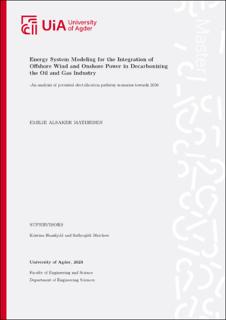| dc.description.abstract | Achieving the green energy transition is a pressing issue to mitigate climate change. This thesis investigates the feasibility and potential of electrifying the Norwegian Continental Shelf (NCS) to reduce emissions to comply with the government's ambitious climate goals towards 2050. An analysis of various scenarios using offshore wind and/or power from shore as electrification alternatives are conducted to determine the most cost-effective solutions, it's impact on the Norwegian energy system, and exploring possibilities of offshore wind in meeting the NCS energy demands. The existing IFE-TIMES-Norway model was updated to implement additional offshore regions and various scenarios were applied to represent the decision problem realistically. To improve the representation of the petroleum industry within TIMES, literature and government electrification plans were incorporated.
The findings highlight the urgency of decarbonizing the NCS and the inadequacy of today's electrification plans for achieving climate targets by 2030. Overall, model simulations indicate that electrifying with power from shore alone or using both offshore wind and shore power results in the most significant reduction in CO2 emissions. As the most cost-effective solution for decarbonizing the petroleum industry, combining shore power and offshore wind power is emphasized. In spite of this, results indicate that offshore wind is a key factor in limiting the impact of electrification on the energy system and increasing the total production of renewable energy sources. There are limitations related to using only power from shore, such as the availability of grid capacity and whether power from shore projects is prioritized over other industrial projects that also wish to connect to the grid to manage electrification measures to meet targets and government plans. Based on today's offshore wind investment costs and government plans, offshore wind alone cannot provide enough energy to cover O&G demand in 2030. The study's model simulations of different scenarios demonstrated that offshore regions were successfully implemented and provided adequate solutions for electrifying the NCS. The development of offshore wind production sites and the electrification of oil and gas platforms is also proposed. | |
